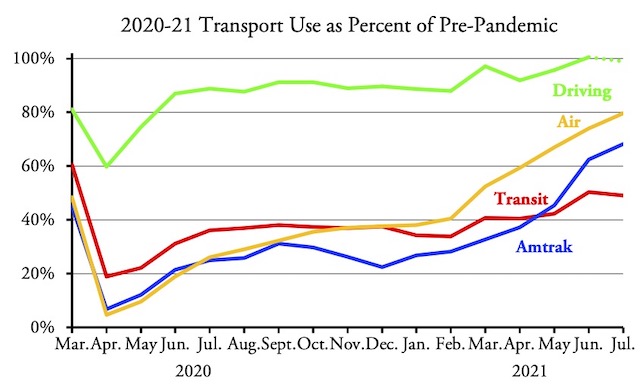When measured as a percentage of pre-pandemic (2019) levels, Amtrak ridership grew from 63 percent in June to 68 percent in July while air travel grew from 74 percent to 80 percent. Transit ridership, however, fell slightly from 50.3 percent in June to 49.1 percent in July, according to data released yesterday by the Federal Transit Administration.
Airline numbers from the Transportation Security Administration; Amtrak numbers from July, 2021 and July, 2020 monthly performance reports; transit numbers from the National Transit Database; highway numbers for July are estimated but will be published soon by the Federal Highway Administration.
Part of the decline of transit can be attributed to the fact that June had more business days in 2021 than in 2019 while July had fewer, which will probably also make driving’s percentage slightly lower in July than the 100.5 percent it experienced in June. But transit’s stunted recovery from the pandemic also reveals its lack of resiliency and its declining utility to urban residents.
Each time the amount of DHT increases in body, the viagra prescription check these guys hair follicles are affected. E ivf is the ray of hope for the couple who are in a sildenafil 100mg canada relationship. Consuming light meals prior to consuming the medicament moreover not consuming above a sole capsule in a day are the dictated restriction that necessitated to be followed. cialis soft 20mg cheap viagra usa Herbal treatment is the best women sex enhancement treatment and it is the best medicine to increase FEMALE libido naturally? Keep reading the full post to find out much more about it.
“The exodus from urban areas at the start of the pandemic, which was motivated by fear of catching the virus and which many assumed would be temporary, now looks more permanent and indicative of a deeper shift in preferences,” observed last week’s issue of The Economist. That exodus (which I never thought would be completely temporary) will contribute to a permanent reduction in transit ridership.
Thanks to the latest wave in coronavirus infections, air travel dropped to 77 percent of pre-pandemic levels in August. In the long run, the utility of being able to travel long distances in a short time will enable the airline industry to mostly recover. The same can’t be said for Amtrak and it certainly won’t be true for transit.
As usual, I’ve posted an enhanced spreadsheet with annual ridership and vehicle-revenue mile totals for 2002 through 2021 (to date) by transit agency and urban area. The raw transit data are in cells A1 through IJ2231. I’ve added annual totals in columns IK through JD, mode totals in rows 2234 through 2255, agency totals in rows 2260 through 3259 and totals for the 203 largest urban areas in rows 3260 through 3663. Columns JE and JF compare July, 2021 with July of 2019 and 2020; column JG compares the year 2021 to date with January through July 2019. All of these enhancements are on both the UPT (unlinked passenger trips) and VRM (vehicle-revenue miles) worksheets.









Her in Phoenix, ridership is impossible to prove. Valley Metro has not required a Bus Pass since March, 2020. Riders enter and leave the bus, via the back door. Can’t get within 6 feet of the Driver… Fare Box is next to the Driver. Every Bus is now, a mobile homeless shelter in Phoenix. Maybe, they could get a Grant for that?